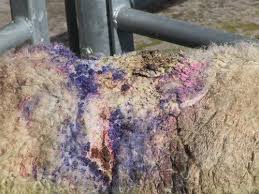Rain scald
20 August 2016Over the last few days I have heard people complaining about sheep having rain scald – so what is it?
It can be called a whole host of different names e.g. lumpy wool, rain rot, mycotic dermatitis, streptotrichosis, dermatophilosis or rain scald. It is basically a skin infection caused by the bacteria, Dermatophilus congolensis. This bacteria is spread through wet conditions and close contact of animals, it is most common on short wool breeds and is usually found if there has been wet weather for a month after shearing. It can be transferred by numerous routes including, direct contact from animal to animal, through contaminated equipment, by insects and anything which may cause damage to the skin. It causes hair loss, crusts and scabs, which may be on the face, tail or along the animals back. The crusts can be removed, but often expose a raw lesion underneath, this can then attract flies. Best practice is to leave the scabs.
Prevention of rain scald includes controlling external parasites, providing shelter from rain and isolating any animals who are showing signs. Treatment will depend on the severity of the rain scald as well as aesthetic looks (sale sheep etc.) but can involve keeping the skin dry, disinfection of the area, penicillin use in severe cases, organic body washes and the final method would be creating a zinc sulphate based solution and applying to the area (10kg zinc sulphate per 1000 litres of dip – if compatible). These could be applied for 3-5 consecutive days then weekly until the scabs shed, which may take several weeks. Affected sheep will however self cure in dry weather, but it is essential to ensure your keeping on top of fly control.
Kirsten Williams, kirsten.williams@sac.co.uk.
Sign up to the FAS newsletter
Receive updates on news, events and publications from Scotland’s Farm Advisory Service

